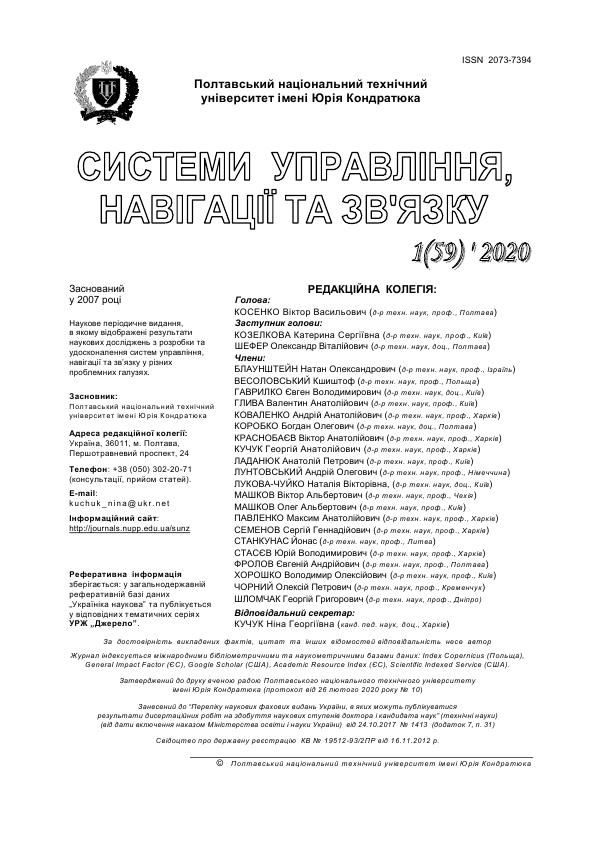ВИБІР МЕТОДА ЛІНГВІСТИЧНОЇ СТЕГАНОГРАФІЇ ДЛЯ ВИКОНАННЯ ЗАВДАНЬ З РЕЄСТРАЦІЇ СЕЙСМІЧНИХ ПОДІЙ
DOI:
https://doi.org/10.26906/SUNZ.2020.1.079Ключові слова:
лінгвістична стеганографія, синтаксичні методи, текстові контейнери, варіативність розділових знаків, пунктуація, кодуванняАнотація
Важливим завданням сьогодення в області захисту інформації є впровадження криптологічних методів. Однак на цьому шляху багато невирішених проблем, пов'язаних з руйнівним впливом на криптозасоби таких складових інформаційної зброї, як комп'ютерні віруси, логічні бомби, автономні реплікативні програми. Метою статті є вивчення особливостей синтаксичних методів лінгвістичної стеганографії. У ході досліджень вирішувались задачі ефективного застосування сил та засобів головного центру спеціального контролю під час передачі для обробки даних реєстрації сейсмічних явищ у ближній та дальній зонах. Об’єктом дослідження в роботі є пунктуаційний метод приховування інформації у текстових контейнерах. Запропоновано використовувати модель приховування повідомлень у текстових контейнерах з відкритим доступом. Це можливо на основі блокування несанкціонованого доступу до інформації шляхом шифрування змісту повідомлень. Предметом дослідження є принципи вбудовування та вилучення повідомлень за реалізованим алгоритмом. Методи дослідження: формалізація теоретичної інформації, порівняльний аналіз, розробка методів реалізацій. Розглянуто також атаки на стеганографічні системи та виділено особливості всіх атак. Перевагу було надано синтаксичному методу на основі пунктуації для здійснення приховування інформації під час передачі даних від периферійних центрів до головного центру приймання і обробки інформації. Кінцевими результатами проведеної роботи передбачена реалізація програми вбудовування та вилучення повідомлення в/з контейнера. Було проведено порівняльний аналіз щодо використання типів текстових контейнерів та здійснено аналіз часових рамок процедур вбудовування та вилучення повідомлення.Вказано також і на можливі недоліки пунктуаційного методу. Такі, як складність програмної реалізації, після якої заповнений контейнер повинен відповідати усім вимогам нормальної стеганосистеми, і . труднощі дотримання вимог до пропускної спроможностіЗавантаження
Посилання
Виноградов Ю. А. Комплексное применение сейсмического и инфразвукового методов регистрации волновых полей для выделения сигналов от наземных взрывов в процессе мониторинга природной среды в Евро-Арктическом регионе: Автореф. дис. канд. техн. наук. Москва, 2004, 26 с.
Дубровин В. И., Смирнов А. А. Совместное использование инфразвуковых и сейсмических данных для повышения точности локализации. Вестник НЯЦРК. 2011. Вып. 3. С. 140-144.
Андрущенко Ю. А., Гордієнко Ю. О. Аналіз ефективності застосування критеріїв ідентифікації вибухів та землетрусів для локальних та регіональних подій в умовах платформної частини України. Геофіз. журн. 2009. Т. 31. No 3. С. 121-129.
Компьютерная стеганография. Теория и практика / Г.Ф. Конахович, А.Ю. Пузыренко – К.: МК – Пресс, 2006 – 288 с.
Основи комп’ютерної стеганографії / Хорошко В.О., Азаров О.Д., Шелест М.Є., Яремчук Ю.Є. – В.: ВДТУ, 2003. – 143 с.
Цифровая стеганография / В.Г. Грибунин, И.Н. Оков, И.В. Туринцев – М: САЛОН-ПЕСС, 2009 – 272с. (Серия «Аспекты защиты»).
Garces, M. A. Traveltimes for infrasonic waves propagating in a stratified atmosphere / M. A. Garces, R. A. Hansen, K. G. Lindquist // Geoph. J. Int., 1998. - P. 135, 255-263.
Beutelspacher A. Kryptologie: Eine Einführung in die Wissenschaft vom Verschlüsseln, Verbergen und Verheimlichen. Berlin: Springer-Verlag, 2009.
Потапова Р. К. Речь: коммуникация, информация, кибернетика. М.: Изд-во УРСС, 2010. 600 с
Лящук О. І., Андрущенко Ю. А., Гордієнко Ю. О., Карягін Є. В. Корнієнко І. В. Можливість використання даних інфразвукового моніторингу під час ідентифікації природи сейсмічних подій. Геофіз. журн. - 2015. - 37, No 6. - С. 105-114.
Gibbons S. J., Ringdal F., Kværna T., 2007. Joint seismic-infrasonic processing of recordings from a repeating source of atmospheric explosions. J. Acoust. Soc. Am. 122 (5), 158-164. doi: 10.1121/1.2784533
Wayner P. Strong Theoretical Steganography. – Berlin: Cryptologia, 2005. 410 p.
Асминг В. Э., Евтюгина З. А., Виноградов Ю. А., Федоров А. В. Анализ инфразвуковых сигналов, генерируемых техногенными источниками. Вестник МГТУ. 2009. Т. 12. No 2. С. 300-307.




